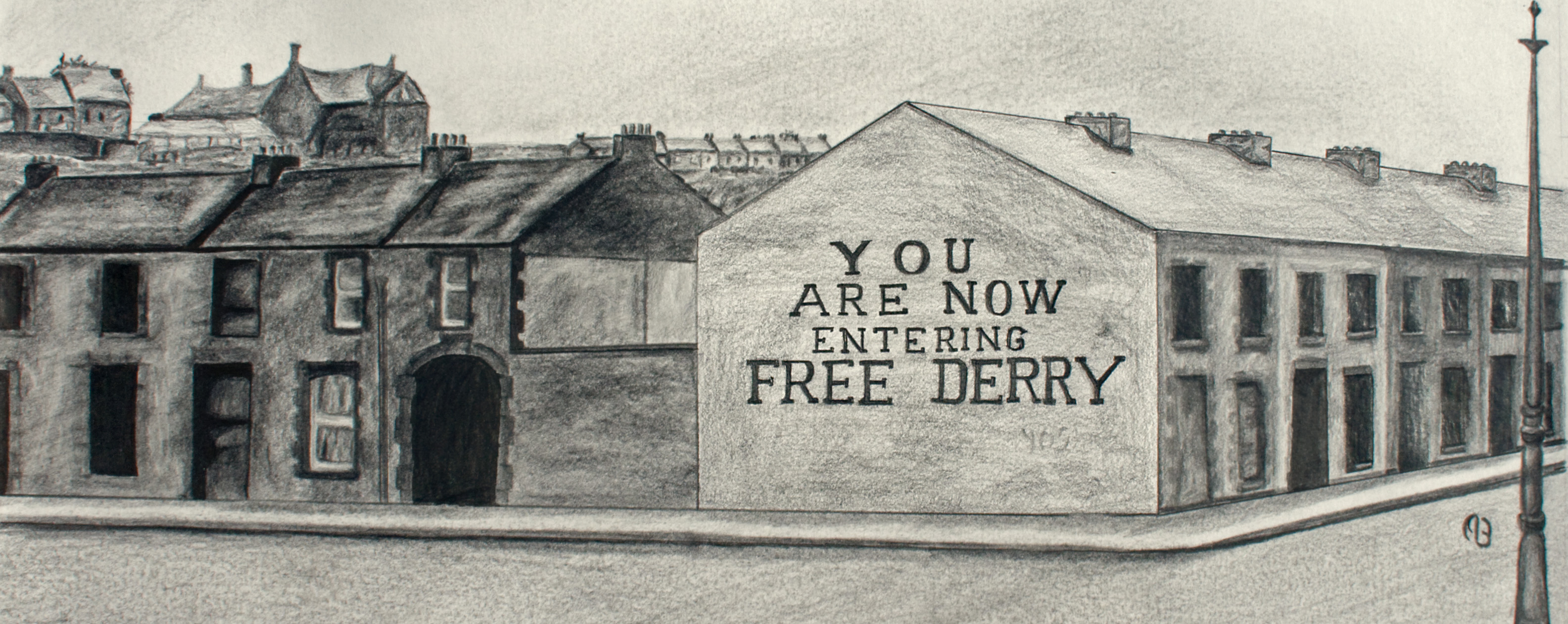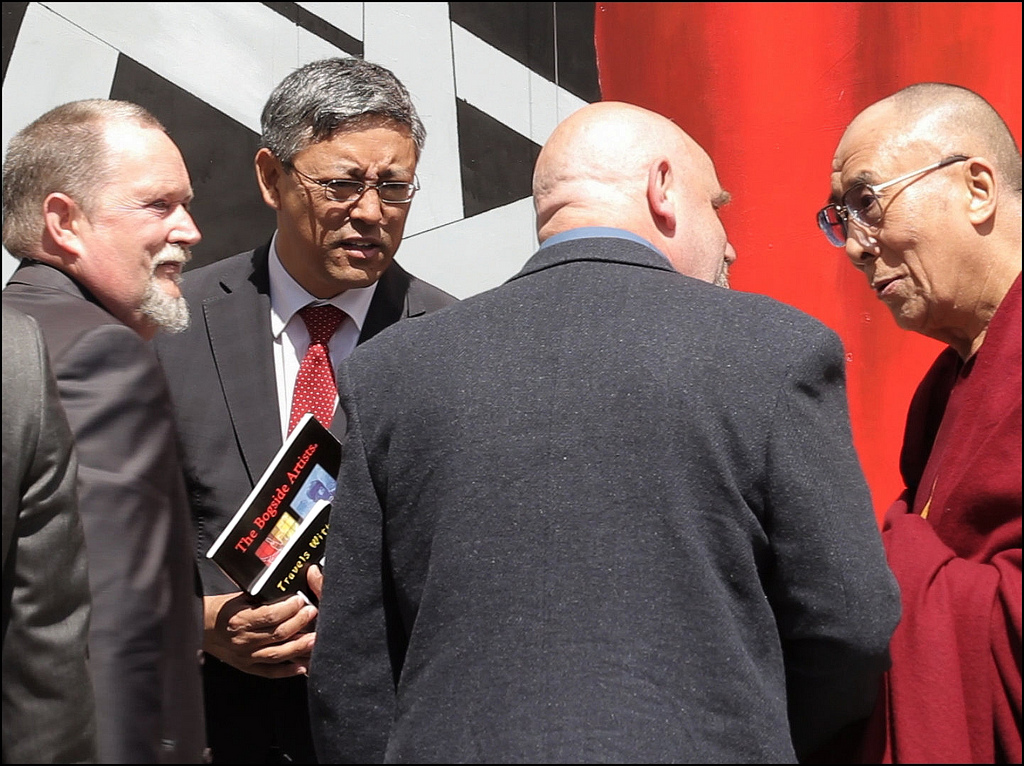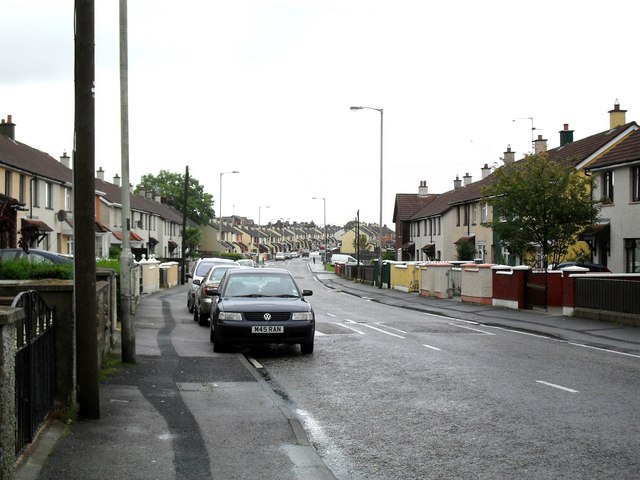|
Bogside
The Bogside is a neighbourhood outside the city walls of Derry, Northern Ireland. The large gable-wall murals by the Bogside Artists, Free Derry Corner and the Gasyard Féile (an annual music and arts festival held in a former gasyard) are popular tourist attractions. The Bogside is a majority Catholic/Irish republican area, and shares a border with the Protestant/Ulster loyalist enclave of the Fountain. History The Troubles The area has been a focus point for many of the events of the Troubles; in 1969, a fierce three-day battle against the RUC and local Protestants—known as the Battle of the Bogside—became a starting point of the Troubles. Between 1969 and 1972, the area along with the Creggan and other Catholic areas became a no-go area for the British Army and police. Both the Official and Provisional IRA openly patrolled the area and local residents often paid subscriptions to both. On 30 January 1972, a march organised by the Northern Ireland Civil Rights Associati ... [...More Info...] [...Related Items...] OR: [Wikipedia] [Google] [Baidu] |
Battle Of The Bogside
The Battle of the Bogside was a large three-day riot that took place from 12 to 14 August 1969 in Derry, Northern Ireland. Thousands of Catholic/Irish nationalist residents of the Bogside district, organised under the Derry Citizens' Defence Association, clashed with the Royal Ulster Constabulary (RUC) and loyalists. It sparked widespread violence elsewhere in Northern Ireland, led to the deployment of British troops, and is often seen as the beginning of the thirty-year conflict known as the Troubles. Violence broke out as the Protestant loyalist Apprentice Boys marched past the Catholic Bogside. The RUC drove back the Catholic crowd and pushed into the Bogside, followed by loyalists who attacked Catholic homes.Stetler, Russell. ''The Battle of Bogside: The Politics of Violence in Northern Ireland''Chapter 3: August. Reproduced by Conflict Archive on the Internet (CAIN). Thousands of Bogside residents beat back the RUC with a hail of stones and petrol bombs.Coogan, Tim Pat. ... [...More Info...] [...Related Items...] OR: [Wikipedia] [Google] [Baidu] |
Free Derry
Free Derry ( ga, Saor Dhoire) was a self-declared autonomous Irish nationalist area of Derry, Northern Ireland, that existed between 1969 and 1972, during the Troubles. It emerged during the Northern Ireland civil rights movement, which sought to end discrimination against the Irish Catholic/nationalist minority by the Protestant/ unionist government. The civil rights movement highlighted the sectarianism and police brutality of the overwhelmingly Protestant police force, the Royal Ulster Constabulary (RUC). The area, which included the mainly-Catholic Bogside and Creggan neighbourhoods, was first secured by community activists on 5 January 1969 following an incursion into the Bogside by RUC officers. Residents built barricades and carried clubs and similar arms to prevent the RUC from entering. Its name was taken from a sign painted on a gable wall in the Bogside which read, "You are now entering Free Derry". For six days the area was a no-go area, after which the residents to ... [...More Info...] [...Related Items...] OR: [Wikipedia] [Google] [Baidu] |
Bogside Artists
The Bogside Artists are a trio of mural painters from Derry, Northern Ireland, consisting of brothers Tom and William Kelly, and Kevin Hasson (b. 8 January 1958). Their most famous work, a series of outdoor murals called the People's Gallery, is located in the Bogside neighbourhood of Derry and depicts the events surrounding sectarian violence and civil rights protests in Northern Ireland during the Troubles. Career The Bogside Artists first began working together in 1993 to document the events surrounding the Northern Ireland Troubles. With supplies donated from local residents, they painted several murals on the walls of Rossville Street buildings commemorating the Battle of Bogside and Bloody Sunday. From 1994 to 2008, they painted a total of twelve murals on this street in the Bogside, which they named 'The People's Gallery''. The People's Gallery spans the entire length of Rossville Street, which runs through the centre of the Bogside. It is a unique visual display – an en ... [...More Info...] [...Related Items...] OR: [Wikipedia] [Google] [Baidu] |
Bloody Sunday (1972)
Bloody Sunday, or the Bogside Massacre, was a massacre on 30 January 1972 when British soldiers shot 26 unarmed civilians during a protest march in the Bogside area of Derry, Northern Ireland. Fourteen people died: thirteen were killed outright, while the death of another man four months later was attributed to his injuries. Many of the victims were shot while fleeing from the soldiers, and some were shot while trying to help the wounded. Other protesters were injured by shrapnel, rubber bullets, or batons, two were run down by British Army vehicles, and some were beaten.'Bloody Sunday', Derry 30 January 1972 – Names of the Dead and Injured . |
Derry
Derry, officially Londonderry (), is the second-largest city in Northern Ireland and the fifth-largest city on the island of Ireland. The name ''Derry'' is an anglicisation of the Old Irish name (modern Irish: ) meaning 'oak grove'. The old walled city lies on the west bank of the River Foyle, which is spanned by two road bridges and one footbridge. The city now covers both banks (Cityside on the west and Waterside on the east). The population of the city was 83,652 at the 2001 Census, while the Derry Urban Area had a population of 90,736. The district administered by Derry City and Strabane District Council contains both Londonderry Port and City of Derry Airport. Derry is close to the border with County Donegal, with which it has had a close link for many centuries. The person traditionally seen as the founder of the original Derry is Saint , a holy man from , the old name for almost all of modern County Donegal, of which the west bank of the Foyle was a part before 1 ... [...More Info...] [...Related Items...] OR: [Wikipedia] [Google] [Baidu] |
The Troubles
The Troubles ( ga, Na Trioblóidí) were an ethno-nationalist conflict in Northern Ireland that lasted about 30 years from the late 1960s to 1998. Also known internationally as the Northern Ireland conflict, it is sometimes described as an "irregular war" or "Low-intensity conflict, low-level war". The conflict began in the late 1960s and is usually deemed to have ended with the Good Friday Agreement of 1998. Although the Troubles mostly took place in Northern Ireland, at times violence spilled over into parts of the Republic of Ireland, England and mainland Europe. The conflict was primarily political and nationalistic, fuelled by historical events. It also had an Ethnic group, ethnic or sectarian dimension but despite use of the terms 'Protestant' and 'Catholic' to refer to the two sides, it was not a Religious war, religious conflict. A key issue was the Partition of Ireland, status of Northern Ireland. Unionism in Ireland, Unionists and Ulster loyalism, loyalists, who for ... [...More Info...] [...Related Items...] OR: [Wikipedia] [Google] [Baidu] |
Creggan, Derry
Creggan ( ga, An Creagán; meaning ''stony place'') is a large housing estate in Derry, Northern Ireland, on a hill not far from the river Foyle. The estate is very close to the border with County Donegal in the Republic of Ireland. History Pre-Troubles Creggan was originally built specifically to provide housing for the growing population of Derry. There was a Irish nationalism, Nationalist majority in the city, but the Unionism in Ireland, Unionist minority of the then Londonderry Corporation wanted to ensure they kept control of the city. When the Bogside became overcrowded in the 1940s to 1960s, the Corporation agreed to put Nationalist and mainly Catholic families in housing, in the same ward as the Bogside. This ensured continued Unionist control of the Londonderry Corporation. This process is known as gerrymandering. As well as the use of gerrymandering by the Corporation, there was also the use of 'restricted franchise' by the Government, where only rate payers had ... [...More Info...] [...Related Items...] OR: [Wikipedia] [Google] [Baidu] |
Free Derry Corner
Free Derry Corner is a historical landmark in the Bogside neighbourhood of Derry, Northern Ireland, which lies in the intersection of the Lecky Road, Rossville Street and Fahan Street. A free-standing gable wall commemorates Free Derry, a self-declared autonomous nationalist area of Derry that existed between 1969 and 1972. On the corner is a memorial to the 1981 hunger strikers and several murals. There is also a memorial to those who died engaging in paramilitary activity as part of the Provisional IRA's Derry Brigade. On 5 January 1969 a local activist, long believed to be John "Caker" Casey, but who might have been Liam Hillen, painted graffiti on a gable wall at the end of a housing terrace stating "You are now entering Free Derry". When the British Home Secretary, Jim Callaghan, visited Derry in August 1969, the "Free Derry" wall was painted white and the "You are now entering Free Derry" sign was professionally re-painted in black lettering. The area in front of the wa ... [...More Info...] [...Related Items...] OR: [Wikipedia] [Google] [Baidu] |
Northern Ireland Civil Rights Association
) was an organisation that campaigned for civil rights in Northern Ireland during the late 1960s and early 1970s. Formed in Belfast on 9 April 1967,NICRA coverage , cain.ulst.ac.uk; accessed 1 January 2016. the civil rights campaign attempted to achieve reform by publicising, documenting, and lobbying for an end to discrimination against Catholics in areas such as elections (which were subject to and property requirements), discrimination in employment, in |
Provisional IRA
The Irish Republican Army (IRA; ), also known as the Provisional Irish Republican Army, and informally as the Provos, was an Irish republicanism, Irish republican paramilitary organisation that sought to end British rule in Northern Ireland, facilitate United Ireland, Irish reunification and bring about an independent, socialist republic encompassing all of Ireland. It was the most active republican paramilitary group during the Troubles. It saw itself as the army of the all-island Irish Republic and as the sole legitimate successor to the Irish Republican Army (1919–1922), original IRA from the Irish War of Independence. It was List of designated terrorist groups, designated a terrorist organisation in the United Kingdom and an unlawful organisation in the Republic of Ireland, both of whose authority it rejected. The Provisional IRA emerged in December 1969, due to a split within Irish Republican Army (1922–1969), the previous incarnation of the IRA and the broader Republic ... [...More Info...] [...Related Items...] OR: [Wikipedia] [Google] [Baidu] |
History Of Derry
The earliest references to the history of Derry date to the 6th century when a monastery was founded there; however, archaeological sites and objects predating this have been found. The name Derry comes from the Old Irish word ''Daire'' (modern: ''Doire'') meaning 'oak grove' or 'oak wood'. Early history In the 6th century, a Christian monastery was founded on the hill of ''Doire'' to the east of the River Foyle. The site was allegedly granted by a local king who had a fortress there. According to legend the monastery of Doire was established by Saint Colmcille/Columba. Colmcille founded many important monasteries in Ireland and Scotland, including Durrow Abbey in the Irish Midlands and Iona on an island off the west of Scotland. The claim that he founded a settlement at Doire is less certain, although that monastery belonged to the federation of Columban churches which looked to Colmcille as their spiritual founder and leader. According to local tradition the location of the f ... [...More Info...] [...Related Items...] OR: [Wikipedia] [Google] [Baidu] |
Derry City Walls
Derry's walls were originally built by the The Honourable The Irish Society, Irish Society between 1613 and 1619, under the supervision of the London builder and architect Peter Benson (architect), Peter Benson. They were built with the intention of protecting the Scottish and English planters that had moved to Ulster as part of the Plantation of Ulster that had been established by James VI and I, James I. It was a direct consequence of the Burning of Derry, previous settlement being destroyed by Irish chieftain Cahir O'Doherty during O'Doherty's rebellion. As a result of the building of the city's defences by the Irish Society, which was a consortium of livery companies based out of the City of London, the city was officially renamed Londonderry in the 1613 royal charter. This is what has subsequently led to the Derry/Londonderry naming dispute, naming dispute for the city and county of Derry/Londonderry. The walls are at the centre of the historic city of Derry and within the ... [...More Info...] [...Related Items...] OR: [Wikipedia] [Google] [Baidu] |









